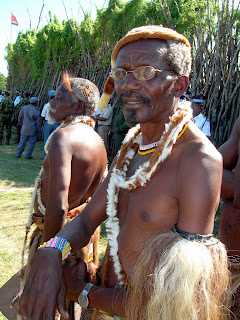The Swazi Ncwala Harvest Festival - Ryan's brush with royalty

The king of Swaziland.
The Ncwala, meaning “First Fruit”, is the Swazi harvest festival. The event honors the King and the Kingdom’s ancestors. It is held in December or January every year. The exact date is chosen by Swazi astronomers and depends on the position of the sun and the phase of the moon.
The Ncwala festival has two parts: the Little Ncwala and the Big Ncwala. The Little Ncwala begins when the Swaziland-based Bemanti clan, or the 'water people', travel to the Mozambican coast and collect the foam from the ocean waves, which they transport back to their native villages.
The Big Ncwala begins when, under the full moon, the youth of the villages begin to collect the sacred branches of the Lusekwana plant (a species of acacia) which they use to build a sacred garden. Tradition states that the plant will wither and disintegrate in the hands of a youth who has lost his virginity, and so the branches, once collected, are well cared for.
The festival also includes the slaughter of a bull, traditional song and dance, and the dressing of the King in ceremonial dress. On the last day of Ncwala, the King, who has been in seclusion for several weeks prior, enters the sacred garden of the Lusekwana branches and consumes the first fruits of the new season (usually the year’s first harvested pumpkin). Once the King has eaten, he shares the pumpkin with his warriors and emerges from the enclosure to bless the Swazi people and their ancestors.
After this blessing, the Swazi people themselves are allowed to consume the remaining first fruits of the annual harvest. The festival ends with the ceremonial burning of [some] of the King's belongings, an act which symbolizes cleansing and preparation for the upcoming year.
The Ncwala festival’s duration depends on the behavior of the sun and moon, but generally lasts up to three weeks. This year, the festival ran a bit late and, though I missed the Mozambican foam-gathering, I was able to catch the ceremony’s finale in early January (the day when the King eats and emerges from seclusion and bless the Swazi people). In an additional stroke of good luck, I was mistaken for a member of the international press and, as His Highness was about to emerge from the garden (just after pumpkin-eating inside), I was carefully ushered through the metal detectors for a close-up view of the king and his warrior entourage.
Below you will find selected photographs and observations gathered in the minutes after this fortuitous case of mistaken identity.
--

My fated journey through security.
The traditional Ncwala uniform of the Swazi warrior was feathery and furry. The warrior’s feet were usually bare. Each ankle was encircled by a loop of white, brown, or black cowhide, as these are the colors of Swaziland’s trichrome cattle herds. Earth-toned cotton fabric was wrapped around the waist. The material had the texture of a crisp, new bedsheet, and was patterned with simple circles, boxes, or lines in some variation of bovine colors, though occasionally a warrior appeared wrapped in fabric with subtle hints of other natural colors, those beyond the cow spectrum (beetroot, squash or carrot, etc.).
Over the waist-wrap, many warriors wore a pelt of leopard or cowhide.

A fellow photographer (warrior-photographer, that is).
Above the waist, there was more inter-warrior variation. Many of the men were shirtless with strips of cowhide around their neck, similar to the ankle loops but with longer hair. Many wore necklaces and bracelets made of small vividly-colored plastic beads, the only obvious interruption in the otherwise organically-themed uniform.

Swazi warrior.
From the fighters’ mid-biceps hung long (30-60cm) tufts of cow hair, apparently from the tail of the animal. It was very coarse in appearance and feel, and gave the illusion that shoulders and arms were broader than they would be without the hairy appendage.
A similar but longer bundle of hair (60-90cm?) surrounded the neck of approximately half of the fighters, giving the appearance of a lion’s mane and effectively disguising any underlying musculoskeletal frailty.

Warriors with manes.
Those warriors with the status and royal lineage that permitted them to don a headdress did so, and it was constructed from tall, black feathers, with red and sometimes yellow feathers intermingled. The result was a sudden increase in the wearer’s stature, a nice accompaniment to the brawny, hairy accents below.
In one hand, the warriors carried a leather shield the shape of an American-style football (but larger and flat), which was stitched to a two-meter wooden rod much like a football’s grip is woven into the underlying pigskin. In the other hand, they carried another long straight, darkly-colored stick (origin and significance unknown).
Such was the proud, elegant uniform of the harvest-time Swazi warrior. Made locally, well-ventilated, and adapted over centuries to inflate and camouflage the Swazi tribe's protectors while belittling and intimidating those who would might seek to do the tribe any harm.
As the king was about to exit his sacred garden (a fort-like enclosure of several dozen square meters with walls of long sticks buried side-by-side in the dirt), a loose ensemble of approximately one hundred Swazi warriors spontaneously gathered at the entrance of the compound.

The amorphous battalion.
They emerged in a cluster and began dancing and chanting. While most faced forward and some stood shoulder to shoulder, many casually ambled about. There was talking and laughing. The King of Swaziland emerged and positioned himself at the front of the slow swarm.
His mane was the broadest, his cow hair the puffiest, his feathers the tallest. His feet were sandaled.
As the amorphous warriors advanced from the fort, he led them in their relaxed, festive advance until, approximately 50 meters in front of the gate, they encountered a regimen of distinctly different soldiers. The soldiers had been waiting there for some time.
These soldiers wore imported polyester suits with shiny black shoes. Their creased pants and sports-car-red jackets were accented by white faux-leather belts and bleached gloves. They clasped a semi-automatic rifle in their lily-white right hand. Their woolen navy-blue hats fit snug and low, shading the eyes. The strong sunlight reflected off the tips of their noses and pursed lips as they stood motionless in formation, their intentionally solemn faces forming a long wavy line, for the ground beneath their feet was slightly uneven.

The polyester-clad soldiers.

The king's procession.
The king approached the soldiers and walked ceremoniously and slowly among the ranks before rejoining his warriors and returning to the fort, at which time Swaziland was officially granted permission to eat freely.

0 Comments:
Post a Comment
<< Home